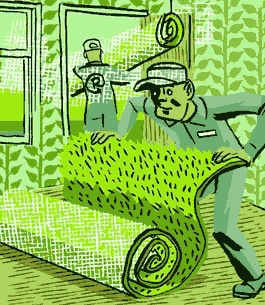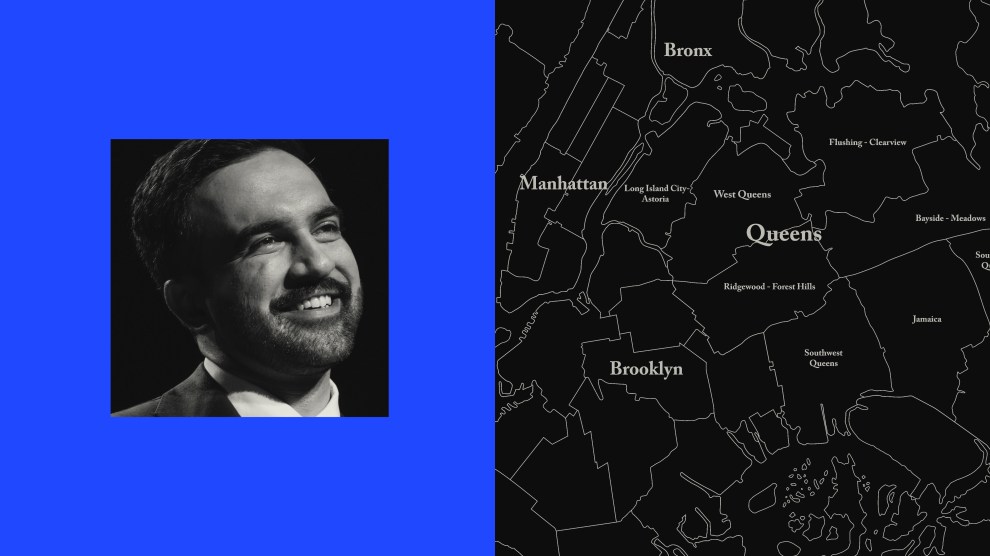
Illustration by: Erik T. Johnson
Ray Anderson’s conversion—what he calls a “spear to the heart”—came in 1994 while he was reading Paul Hawken’s The Ecology of Commerce. In it, the Smith & Hawken cofounder argued that business should inspire a more sustainable model that respects, and even mimics, the natural world. Anderson, CEO of carpet maker Interface, was so struck by Hawken’s message that he sent his staff to tally up the resources used by Interface and its suppliers. The results were staggering: 1.2 billion pounds of raw material were extracted from the earth to produce the roughly $800 million worth of carpeting Interface sold in 1995. Anderson, you might say, was floored.
It’s one thing to be green when you make yogurt, toothpaste, or ice cream. But what do you do when your product is made largely from oil, takes 20,000 Btu of energy per pound to produce, and lasts in the environment for 50,000 years? As Anderson wrote in his widely cited 1998 memoir, Mid-Course Correction, “I am a plunderer of the earth and a thief.” But “by our civilization’s definition, I am a captain of industry…a modern day hero, an entrepreneur.”
That dichotomy sums up the challenge facing a sustainable business model. Traditional economic and accounting systems value growth and profit, without much concern for the means. Standard accounting has no place for the forests, oceans, streams, and atmosphere, and the services they provide, such as recycling carbon dioxide, producing oxygen, processing waste, and generally sustaining life. Nor does a company’s income statement count the depletion of these resources as a cost. “The Soviet Union collapsed because it was economically dishonest,” says Anderson. “If we collapse, it will be because we are ecologically dishonest.”
Anderson makes this pronouncement from Interface’s headquarters on the 20th floor of an office tower atop a bluff on the outskirts of Atlanta. It was from this vantage point, he says, that General William Tecumseh Sherman watched the city burn, and it is here that Buddy Hay plots to stave off damage of another sort. A former accountant, Hay is the manager of sustainability operations at Interface. His small but eclectic group—composed of engineers, accountants, and an environmental lawyer—monitors Interface’s EcoMetrics, or what Hay describes as “our metabolism: how much we take in, in raw materials and energy, and what comes out, in the form of products and waste.” Each of Interface’s 15 plants around the world reports on hundreds of EcoMetrics—ranging from employees’ commuting miles to energy usage per unit of product—that Hay and his team analyze quarterly. The metrics serve mainly as internal measures of progress; such efforts barely register in conventional financial circles. “Wall Street only cares about one thing, and that’s the bottom line,” says John Baugh, an analyst who tracks Interface for brokerage firm Stifel Nicolaus & Co. While Baugh admits that Interface’s environmental initiatives appeal to its customers, they don’t factor into his analysis. “Did they get a return on the money spent? That’s hard to measure,” he says.
By its own measure, Interface has made significant returns on its green investment. Since 1995 the company has eliminated $316 million worth of waste, enough to entirely fund its sustainability efforts. As Hay gets more specific, the numbers fly by: 93 million pounds of material diverted from landfills, enough to carpet the Empire State Building 45 times. The energy used to manufacture each square yard of carpet is down 41 percent, a savings that, last year, equaled 61,000 barrels of oil. Greenhouse gas emissions are 56 percent lower—the equivalent of taking 21,000 cars off the road for a year. Water usage is down 73 percent, one-third of factory smokestacks are shuttered, more than half of all effluent pipes have been closed off. Meanwhile, sales have increased to $1 billion, making Interface the world’s largest seller of modular carpet tiles. The company is almost halfway to its goal of zero waste by 2020, earning it the good will of environmentalists and spawning a green office industry. But there have been missteps.
When Interface embarked on its first major recycling effort in 1996—of carpet backing made of vinyl—the assumption, logically enough, was that any recycling was good. Interface sent used carpet off to a contractor, which recycled it into sheets of backing material and shipped it back. But a few years later, when Interface analyzed the full life-cycle costs of the program, it found that once the contractor’s coal-fired process and waste streams were factored in, the recycled product had a greater environmental impact than carpet made of virgin materials. “That was a real eye-opener,” says Paul Firth, Interface’s manager of environmental initiatives. So Interface brought its recycling efforts in-house. One result is the new Cool Blue recycling process at the company’s carpet-backing plant in LaGrange, Georgia, 70 miles from Atlanta. A 300-foot assembly line snakes through the factory floor. It begins with receptacles boldly labeled “Cool Blue Food”—carpet scraps and other plastics that are ground into “crumb.” The crumb is fed into what resembles a giant pasta machine, which then spits out plastic pellets that are blown onto a conveyor belt and ferried into a hulking oven where they are pressed into sheets of carpet backing. The whole operation is run on natural gas generated from a local landfill.
Life-cycle analysis has also become a standard practice at the company, and Firth, a chemical engineer who joined Interface in 1999 while still in college, is the company’s resident expert. He points to an intricate spiderweb of a chart as he explains that each decision—whether to use a new material, adopt a new process, or launch a new product—is meticulously studied for its impact on a dozen or more areas. Energy usage, water usage, global warming potential, ozone depletion, and human toxicity are all considered, from the moment raw materials are extracted to the final disposal of a product.
This footprint analysis is a powerful tool, but it can sometimes raise perplexing questions. For example, if an alternative material reduces energy use by 50 percent but introduces a material that could degrade into a dangerous toxin, which is the better choice? Some critics have knocked Interface for using polyvinyl chloride (PVC), which can break down into dioxin, a carcinogen, in its carpet backing. “I respect many things Interface has done to reduce its environmental impact, but they are wrong on the PVC issue,” says Tom Lent, technical policy coordinator at Healthy Building Network. But while other carpet makers have switched to alternatives such as ethyl vinyl acetate (EVA), Interface’s preliminary life-cycle analysis found EVA can be four to five times more toxic than PVC.
Gathering data is another issue. “The biggest problem is when your supplier doesn’t know,” says Firth. To get around that, Interface relies on data from governments and consultants that track environmental and toxicity figures. Even when a supplier has analyzed its product, there can be complications. Since 2003, Interface has been using polylactide (PLA), a corn-based fiber made by NatureWorks—a subsidiary of food giant Cargill—to supplement nylon in its carpet facing. Replacing oil-intensive nylon with a bio-based renewable material should be a no-brainer, right? But once the resources involved in growing and harvesting the corn are factored in, the picture is hazier. Fertilizer, for example, contributes to aquatic toxicity and acid rain. Firth says, “The idea of PLA is great, but it’s not the end-all answer yet.”
These issues are thorny enough. But think for a moment of the wider costs—of deploying troops to protect oil interests, for example, or repairing flood damage made more severe by global warming, or medical expenses stemming from pollution-related illnesses. “What is the true cost? Can you ever really say?” asks Hay.
Maybe not. But unlike most companies, Interface has taken great steps to try. And lately, Anderson has been busy fielding calls from other business leaders who are beginning to grapple with the same questions. Interface has created a new consulting group, Raise, to help other organizations starting down the path to sustainability. Anderson sees this as a key step toward his goal of turning Interface into a “restorative company.” One of his clients is Wal-Mart.

















